|
|
Identified European Instruments |
Move mouse cursor over images to identify which images will expand (pointer changes to a hand)
See bottom of page for image copyright information
Soffren Degen, c.1847, with his patented 7-string (1 floating bass) "heptacord," built by Carl Knudsen.
Courtesy of Erling Moldrup, from Guitaren: Et eksotisk instrument i den danske musik.Croatian guitarist Ivan Padovec, c.1841 with 10-course harp guitar built by Schenk, a disciple of J. G. Stauffer. Engraving of Padovec with Schenk instrument.
According to luthier Richard Bruné, Lebedeff appears in this circa 1900 photo of the Moscow branch of the International Association of Guitarists - wit h the very 1861 Scherzer instrument that passed through Bruné's shop! To my inexperienced eye, it looks like nearly the whole group is playing Scherzers, or copies!
 |
The same image (poor, but un-cropped) from the Phillip Bone book shows the strange small (terz?) guitar, and Coste's custom extra large guitar that was tuned a fifth lower. |  |
 |
|
French virtuoso Napoleon Coste with one of his Lacote "floating 7th string" harp guitars. The strange instrument next to it is an arch-cittern - similar or identical to the 1787 Renault & Chatekain specimen in the Arch-citterns Gallery. |
An earlier photo of Coste, with Lacote guitar. | Willi
Meier-Pauselius (with his father George), with a Lacote. See also 2 Meier photos with his custom HG on Unidentified European Instruments. |
|
| Both courtesy of Erling Moldrup, from Guitaren: Et eksotisk instrument i den danske musik. | |||
 |
 |
|
Heinrich
Albert and the Munich Guitar Quartet, 1912. |
Academy Guitar Quartet of Vienna with Hauser quint-bass. |
|
|
|
The French
caption for this 1970s clipping translates: "You will not often see this kind of
guitar: The bow guitarre (Bogenguitarre) which Erich Ferstl from Munich (Germany)
plays, may be the only of its kind in playing condition. This guitar was made in 1930
from a hundred year old drawing. The sound of this instrument, which has 3 holes is close to the harp." |
| In Austria, "contra" or "bass" guitars eventually became known as "Schrammel" guitars - named after a general style of popular yet refined music developed by the Schrammel brothers. The original group included an 1879 Joseph Swosil guitar, which epitomized the instrument. |
 |
 |
| The harp guitarist, Anton Strohmayer | The group in 1884 |
 |
 |
| And in 1890 | |
 |
 |
|
From the recent CD cover |
Nino Catania (shown in above row at left) - Taraffo's frequent partner, here with his own harp instrument - a hollow arm "pseudo" harp mandolin. |
 |
 |
| A label found inside a standard guitar by this maker hints at a wonderful harp guitar to search for! | DiMauro catalog page, vintage unknown (1930-1940s) |
 |
| The shop
of Antonio IV Monzino (1847-1930 & Sons, Milan, 1914. Several harp guitars
can barely be seen behind and to the right of the lyre-shaped guitar. And
check out the guitar/violoncello hybrids!
See Monzino for more spectacular instruments! |
 |
 |
| The
Hawaiian Quintette from a 1917 Chautauqua
brochure have an unusual harp guitar that seems to match one built by
Italian Emanuele Egildo in our Form
1c Gallery. (image courtesy of the Special Collections Department, University of Iowa Libraries) |
The Mowana
Hawaiian Quartette, also from the Chautauqua
concert circuit, appear to have the exact same harp guitar, though the
players look different. (image courtesy of the Special Collections Department, University of Iowa Libraries) |
|
According to Torres author José L Romanillos, Antonio de Torres (1817-92) made three eleven stringed guitars. These were said to be his interpretation of the Germanic bass-guitar (Kontra guitare). Although Torres had seven strings on the fingerboard and the other four lay off the fingerboard. The first one, Torres's 'SE 07' was made in 1876 and was owned by José Martinez Toboso (pictured). The 'SE' stands for the 'Second Epoch' of Torres's life of guitar making. In this era he numbered his instruments. The 'SE 07' guitar was inherited by Maria Terol, who unfortunately had it converted from eleven strings to six strings by Marcelo Barbero in 1945. The guitar has cypress wood back and sides, which is normally associated with flamenco guitars. The best reason for using cypress is that it is not as heavy as rosewood and that it was a local wood and so cheaper than rosewood, which had to be imported. This guitar has a three-piece spruce soundboard. -Stephen Sedwick. |
According to scholar Stephen Sedgwick, Ramirez built at least one 9-string and one 11-string harp guitar, adding that Segovia's famous Ramirez was originally an 11-string. In this photo, "The instrument far right is an 11-string. The 10-string came about with Yepes and so there weren't any before that, that have come to light in Spain. There only seems to be 11-strings in Spain. It is hard to make out any detail but look at the bridge. It extends on the bass side and ends close to the edge of the body. as on my copy and the Torres instruments. The neck width is much wider than the other guitar in the picture. You can just make out the nut as a line that extends towards the bass side and off the fingerboard. To find the nut look in line with the nut on the other guitar in the window." |
 |
 |
| Carlos Garcia Tolsa (1858-1905) of Spain, holding what may be an 11-string by "hiros de Gonzalez" according to guitar scholars Françoise & Daniel Sinier de Ridder | This remarkable instrument
was built by the player, Spaniard Luis Soria in the late 1890s (See Soria in Historical Makers) (image copyright and courtesy Ignacio Ramos Altamira, 2006 |
|
|
 |
|
|
Swede Oscar
Ahnfelt with his 10-string Otto Selling harp guitar. |
This rare cabinet card photographed in Michigan shows a Swedish harp guitar that is very likely another rare Selling specimen (see bottom of Form 2c Gallery). |
|
|
A Russian ensemble from a 1900s Zimmerman catalog. |
|
If you enjoyed this page, or found it useful for research, please consider supporting Harpguitars.net so that this information will be available for others like you and to future generations. Thanks!
|
|
If you enjoyed this article, or found it
useful for research, please consider making a donation to The
Harp Guitar Foundation, |
|
|
|
All Site Contents Copyright © Gregg Miner,2004-2020. All Rights Reserved. Copyright and Fair Use of material and use of images: See Copyright and Fair Use policy. |